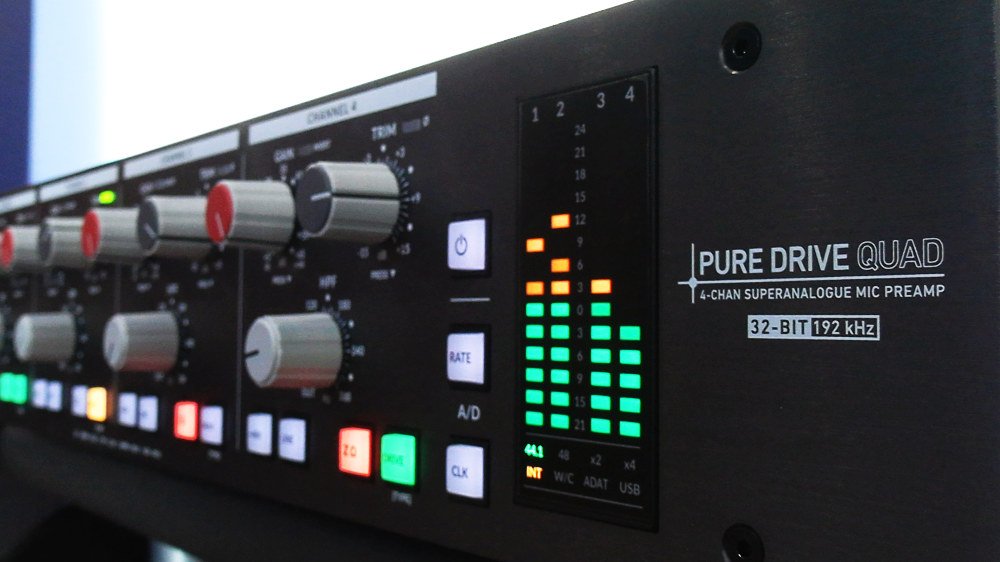For decades, SSL has been synonymous with top-quality analogue mixing consoles.

From the legendary J and K series to the modern Origin, Duality Fuse, and TriniTy models, SSL is often associated with questions like "How many channels?" and "Does it have the mix-bus compressor?" However, the mic preamps in these consoles are less frequently discussed. Unlike vintage SSL components that are often re-sold or raved about on audio forums, SSL mic preamps haven’t received the same attention. To address this, SSL has redesigned its preamps, aiming to combine the clean, high-end fidelity of earlier designs with the option of harmonic color that was previously missing.
The Origin of SSL's Variable Harmonic Drive (VHD) Preamps
SSL introduced their Variable Harmonic Drive (VHD) preamps in 2006 with the first Duality console. The goal was to provide a high-definition, low-noise, transparent preamp with an added twist—users could introduce harmonic 'drive' and distortion through a variable input gain and output trim control. The design was refined further with the release of the large-format Origin console in 2019, a move that was well-received. This success led SSL to offer the VHD preamps in various rack-mounted formats, making the new SSL preamp sound accessible to smaller studios and home recordists. The latest in this line of offerings are the Pure Drive Octo and Quad, which also include high-grade conversion and digital interfacing.
Design and Functionality of the Pure Drive Quad
The Pure Drive Quad stands out not just for its four VHD preamps but also for its broader capabilities. The back panel reveals a unit that is much more than a simple four-channel mic preamplifier. The multi-function input sockets accept both XLR microphone inputs and balanced 1/4-inch jack inputs, allowing line signals to be run through the Pure Drive circuitry. Additionally, the unit can serve as a fully functional USB audio interface, supporting sample rates up to 32-bit/196k. The connectivity options on the rear include D-Sub for four insert returns and four dedicated line inputs, BNC wordclock in and out, AES and ADAT outputs, and a 'Link In' socket for ADAT input or cascading multiple Pure Drive units.
SSL allows the AES and ADAT digital connections to be repurposed as additional analogue outputs, making the unit capable of operating as a 12-in/12-out interface, though only at the lower sample rates of 44.1/48k. As with many similar interfaces, the channel count decreases as the sample rate increases, with 8-in/8-out at 88.2/96k and six channels at 176.4/192k. The unit lacks certain features like monitor and headphone outputs, master volume controls, and dedicated software, making it more suitable as an expansion unit for an existing setup. However, its build quality, cutting-edge conversion, and versatile preamps make the Pure Drive Quad a powerful audio tool that can easily hold its own in off-studio recordings or live gigs.
Front Panel and Controls
While the Pure Drive Quad may have limitations as a studio centerpiece, the quality and utility of its features are undeniable. The front panel emphasizes the four preamp channels with a modern and spacious layout. Each channel has dedicated controls for continuously-variable stepped preamp gain, trim, and a high-pass filter.
A push of any channel’s gain knob enables the insert circuit, making it ideal for effortless A/B testing of EQ and dynamics processing chains. Similarly, pushing the Trim button flips the channel’s phase, both actions being signaled by small LED indicators.
At the bottom of each channel, there are dedicated pushbuttons for phantom power, line input, hi-Z input, and Drive. The Drive function is bypassed when the button is white but turns yellow when the Classic Drive circuit is engaged, introducing subtle odd harmonics that musically color the sound. Holding the Drive button down switches it from yellow to green, activating the Asymmetric Drive mode. This mode is more aggressive, emphasizing even harmonic content to add thickness, color, and soften transients.
To the right of the channel controls are additional pushbuttons for standby mode and wordclock setup, with a pair of 14-segment LEDs providing clear visual feedback on input levels. SSL has thoughtfully designed the unit, allowing users to adjust the brightness of the backlit buttons and other indicators, as well as tweak the meters' brightness, ballistics, and peak hold/release settings. There's also a safe mode for polarity and send/return switch isolation, further demonstrating SSL's commitment to detail.
Integration and Performance
Connecting the Pure Drive Quad to my existing setup was straightforward, requiring only a USB-C connection to my iMac and the creation of a new Aggregate Device that included my existing UAD Apollo, RME converters, and the 12 inputs and outputs of the Pure Drive Quad. The setup automatically adjusts when changing sample rates, so there's no need to reconfigure the inputs and outputs.
My initial listening tests involved comparing the SSL’s conversion quality with my other converters using line-level program material. With a dynamic range of 119dB and a frequency response of ±0.035dB down to 5Hz, the SSL’s analogue-to-digital conversion is impressive, boasting low distortion and crosstalk figures. Unsurprisingly, the sound quality was excellent, delivering a smooth, musical yet accurate sound with a satisfyingly wide and deep soundstage. The Pure Drive Quad holds its own against other converters in its price range, and its sound quality is top-notch, making it a strong contender in the market.